Scotland's capital city, Edinburgh, can be a great jumping-off point for trips up into the Highlands - and down into the Low. But before heading out of the city of half a million Scots, there are things to see and do. First off, however, learn to say "Edinburrah" and not "Edinburg" or you will suffer cutting glances from the Scots.
Edingburgh's new town area can be exciting as can a stroll along Princes Street from Waverley Station, the only train station I know that was named for a novel. (The station and the bridge in front of it bear the name of Sir Walter Scott's series of over twenty novels, one of which was Ivanhoe.)
Scott's importance to the city's self image is clear from the prominence of the monument adjacent to the station. It towers 200 feet above the street as shelter for a statue of its hero.
| |
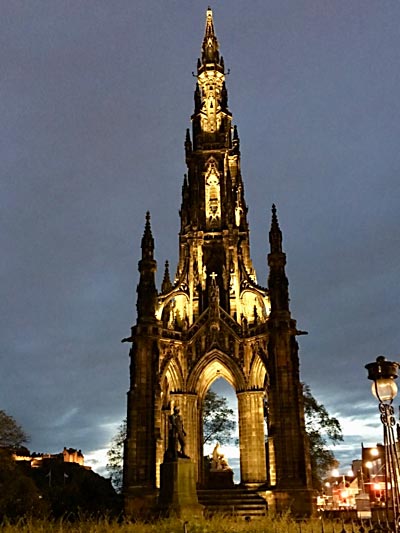 |
|
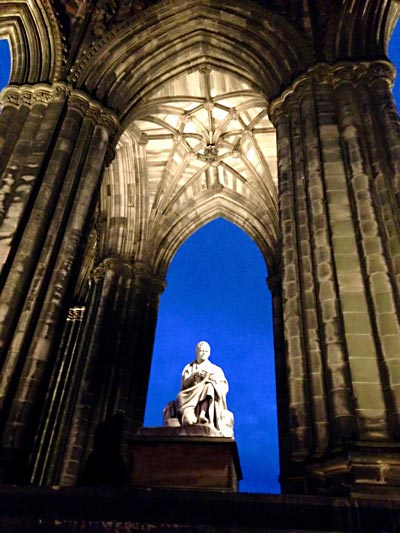 |
|
| |
Edinburgh's fancifully gothic monument to the national hero Sir Walter Scott. |
|
Sir Walter himself in marble under the canopy of the monument. |
|
Hovering above Waverley Station, Princes Street and the Scott Monument is the bluff of the old town with Edinburgh Castle on the prow.
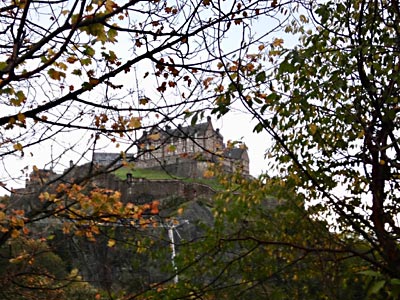
Edinburgh Castle sits on Castle Hill overlooking the
new town of Scotland's capitol city.
The climb up Castle Hill offers a few diversions, including the sight of a robotic lawn mower that has replaced the grazing sheep as a way to keep the turf trimmed. Not to worry, however. Scotland still boasts more sheep (six and a half million) than people (only five and a half million).
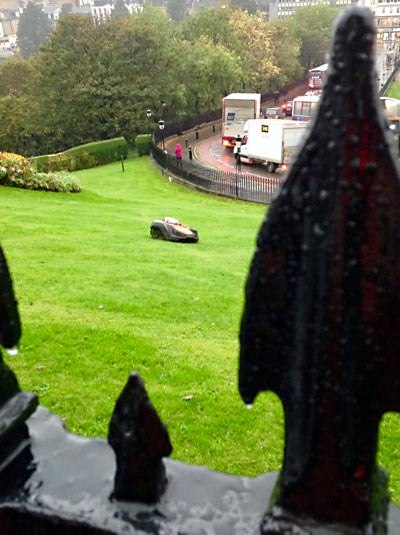
Robot mowers do the work of the sheep who used to graze
on the lawns on the side of Castle Hill.
At the top you reach the paved parade field in front of the old castle.
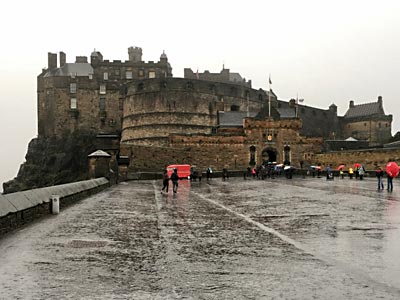
Edinburgh Castle's complex sits behind a great
paved parade ground at the top of the "Royal Mile."
It is all down hill from there - literally. The sights of Old Town flank the down-hill street that bears multiple names. Collectively it is just the "Royal Mile," as it is the route Queen Elizabeth takes on her way to functions at the Castle from her official residence in Holyrood Palace at its foot.
One of the first notable features you reach as you stroll down is St. Giles Cathedral - an imposing collection of structural elements mashed together over time. There has been a church here for over a thousand years and what you see today was a Catholic Cathedral before the Scottish Reformation when it became the beacon of Scottish Presbyterianism.
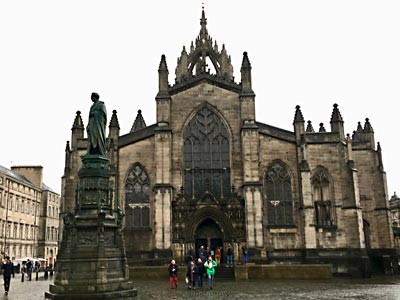
St. Giles Cathedral dominates the middle of the "Royal Mile."
While the sumptuous interior is all you would expect from the exterior, the surprise is that the cafe in the basement is also worth a visit. No, the lattes aren't better than elsewhere. But while you sip your coffee you should check out the tiny stained glass windows deeply recessed into the stone walls. These bits of glass are fragments of pre-reformation stained glass found during recent work on the cafe area and incorporated into the structure. Most are simple patterns but there is a small human figure in one and an animal that may be a goat or perhaps a rabbit in another. Check it out!
| |
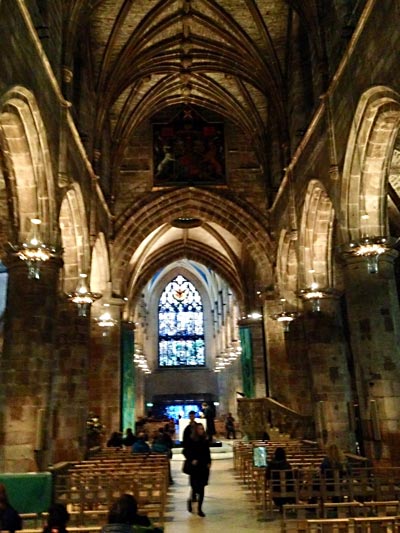 |
|

|
|
| |
At ground level, the interior of St. Giles is impressive with a hushed quiet of solemnity. |
|
In St. Giles Cathedral's basement the real treat in the cafe is the new-found old stained glass. |
|
At the end of the Royal Mile is, of course, Elizabeth's Palace at Holyroodhouse ... most people just call it Holyrood Palace.
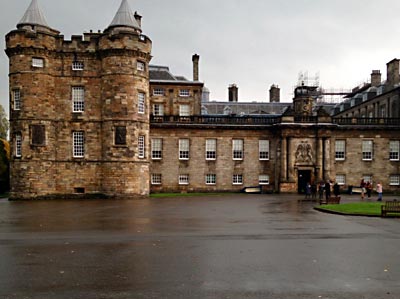
One of two of Queen Elizabeth's residences in Scotland is Holyrood Palace.
The tour of the residence - open when she's not there - is a fairly typical tour of one of her residences (she has seven others). But the really intriguing part of a visit is the ruins of the abbey, the grounds of which the palace occupies. Partially demolished during the reign of Mary, Queen of Scotts, the ruins are amazingly evocative - demanding a hush even though the windows are empty and the roof is gone.
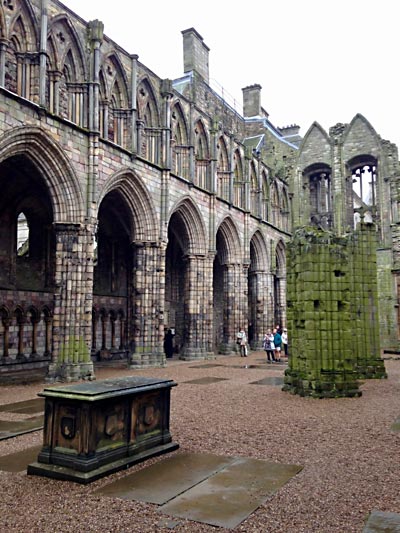
The Queen's palace is on the grounds of this ancient abbey.
Once the pleasures of Edinburgh have been sampled, it is time to head for the Highlands. A two hour drive will take you to Pitlochry, a logical base for exploration. It is a town of about 3,000 with enticements of its own, as well as proximity to the uniquely Scottish sights of the Highlands. It is home to an attraction that this year drew over seventy-thousand visitors - a sound and light show in the Loch Dunmore Faskally Wood, about two miles out of town. Called "The Enchanted Forest," the woods surrounding a small loch (lake) are lit up at night with fantastical effects, celtic-sounding-new-wave music and water features. Enchanted it is indeed!
| |
|
|
|
|
| |
Multi-colored lights make the Enchanted Forest of Pitlochry glow. |
|
Blair Castle is where Queen Victoria developed her fascination with the Scottish Highlands. |
|
| |
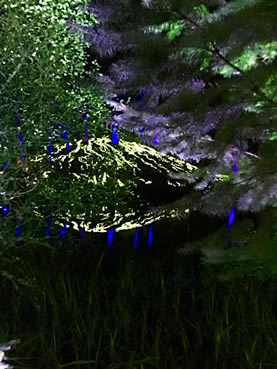 |
|
Even the hills sprout lights in the Enchanted Forest. A few miles beyond the forest and lake lies Blair Castle, which has grown over seven centuries from a mere lodge to a classic 18th-century-style mansion for a family dating back through nearly twenty generations. It was here, they say, that in 1844 Queen Victoria fell in love with the Highlands. |
|
On the other side of town is a distillery on the banks of a swift-flowing stream. It is not just any distillery, but the smallesttraditional distillery in all of Scotland. How small? So small, that when we saw the day's barrels being transferred from the aging building to the bottling facility, it was the owner himself, Andrew Symington, who was driving the fork lift.
| |
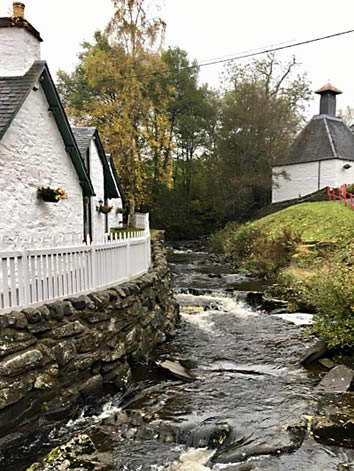 |
|
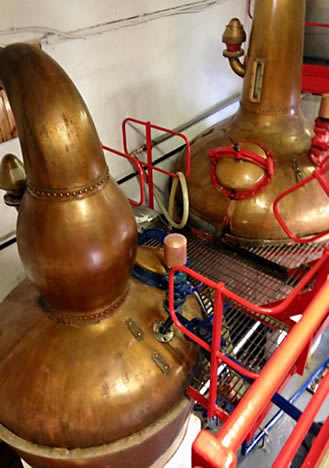 |
|
| |
The smallest traditional distillery in Scotland is Edradour. |
|
A still is the basic equipment for even the smallest traditional distillery. |
|
| |
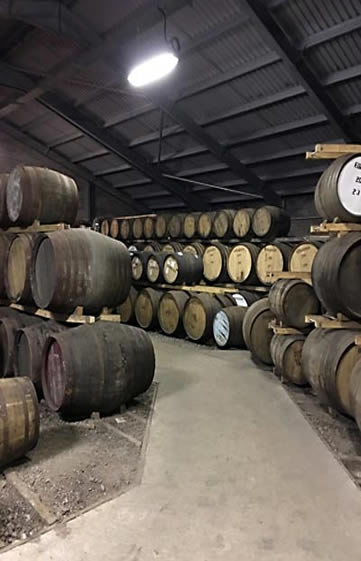 |
|
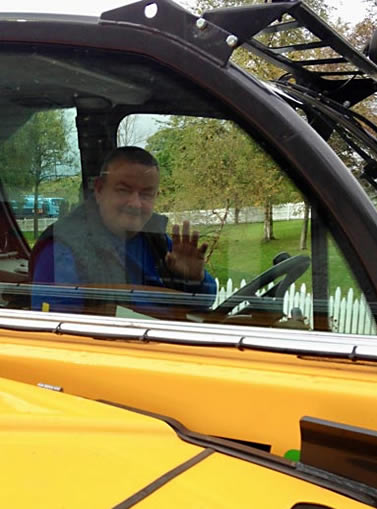 |
|
| |
Scotland wouldn't be Scotland without barrels of Scotch aging in distilleries across the land. |
|
The Edradour Distillery is so small that the owner often drives the fork lift himself. |
|
The distillery offers tours and tastings - of course. What would a visit to Scotland be without Scotch?
Further north into the Highlands is the site everyone wants to check out...Nessie's home in Loch Ness, Scotland's largest loch by volume and second largest by surface area. Its extreme depth (over 750 feet) may account for the rumors that some sort of fresh-water monster might lurk in its depths. At its southern end, the loch connects via the Caledonian Canal to Loch Oich.
| |
|
|
|
|
|
|
| |
Loch Ness offers almost 25 miles of open water.
|
|
At the southern end of Loch Ness, the waters lead in to the locks of the Caledonian Canal. |
|
The doors swing open on the locks that raise boats to the level of the Caledonian Canal. |
|
Further north is the first (and only) disappointing site of our Scottish adventure - the Culloden Battlefield Visitor Center.
Culloden is hallowed ground for the Scotts in much the same way that Gettysburg is hallowed for Americans. It is the site of the battle of 1746 which brought to an end the Jacobite Rebellion that sought to restore the Stuart Monarchy.
It isn't the battlefield itself, however, that disappoints. No, the battlefield, while marred by modern paved trails (and an occasional doggie poop bin) still holds the power to engage the emotions. But a visitor center has been built adjacent to the site which we found to be poorly curated and distractingly gimmicky. Ah, well, not everything can please everyone!
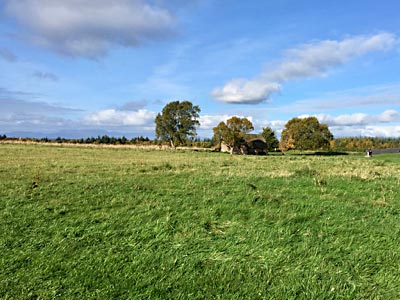
The open field where as many as 2,000 rebels
were killed or wounded in one bloody morning.
Nearby, there is another castle worth a visit - if only for its connection to a piece of literature: Shakespeare's tale of Scottish intrigue and murder. In the famous opening scene in which Macbeth is confronted by a trio of witches we hear him hailed as "Thane of Cawdor." Most of us don't know what a thane is (in Scotland it was the title of a man who held land granted by the Scottish king) but even fewer know what or where Cawdor might be.
It turns out that there really is a Thane of Cawdor, although the real Macbeth couldn't claim that title. The castle of the lineage is still standing and the Dowager Countess of Cawdor lives there still and in some splendor. The castle she occupies dates from long after the days of Macbeth, but the place is beautiful and the connection to the Bard makes it stand out among the many Scottish castles available for a visit.
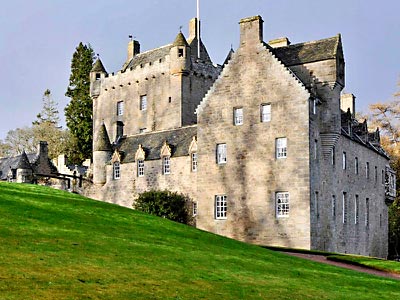
Shakespeare never visited Cawdor Castle before writing MacBeth,
but it is now open in season to visitors.
Heading back south toward the Lowlands there are still stops to be made in the High.
Loch Ness isn't the only lake or river of interest. Indeed, the Highlands offer a wealth of water features. We took a jaunt over to Aberfeldy on the River Tay to view a reproduction of a crannog, the ancient huts built on stilts in the lochs in Scotland as long ago as perhaps 2,500 years. The Scottish Trust for Underwater Archeology, which is conducting studies of the remains discovered under the waters of Loch Tay, built this reproduction "as an experiment to rediscover ancient technology and gain insight into how our Iron Age ancestors managed (the) sophisticated engineering feat."
| |
|
|
|
|
| |
The Crannog Centre is on the scenic shore
of Loch Tay. |
|
Using all the lessons learned from the ruins under Loch Tay, the center recreated this crannog. |
|
Not all the opportunities to see ancient works involve reproductions. The evidence of human activity and even of ceremonial religious activity going back thousands of years is to be seen throughout Scotland, often in plain view as you drive down a road.
The Croft Moraig Stone Circle is in the front yard of a farm house on a rural road simply called A827. It called to us as we drove by, so we pulled over, parked and walked over to it. It isn't of the awesome scale of England's Stonehenge, but it is so much more accessible that it gives you a feeling of connection to the ancients.
This stone circle (or "standing stones" if you prefer the term Paul McCartney used for his second classical orchestral composition) is on a site that may have been used for religious purposes as long ago as 5,000 years. At first it was probably just a wooden structure. No one knows exactly when that was replaced with stones.
| |
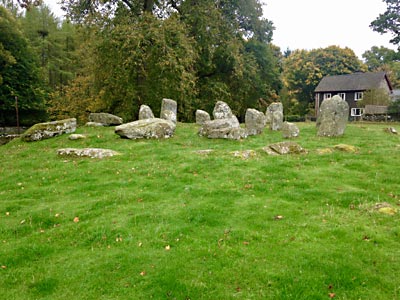 |
|
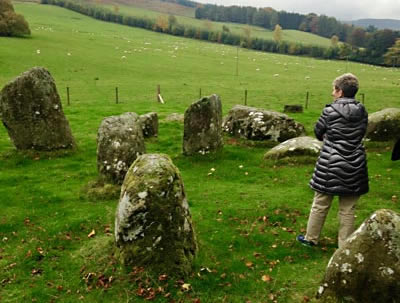 |
|
| |
In the front yard of a farm house, a circle of standing stones is just off the roadway. |
|
The circle may not be as gigantic as Stonehenge, but the presence of the ancients is palpable. |
|
Not all the attractions of Scotland lie north of the Highland Boundary Fault, the traditional divide. The Lowlands offer spectacle and history as well. Driving south from Pitlochry into the Central Lowlands, detour to the town of Falkirk for a chance to see two things you won't find anywhere else: The Falkirk Wheel and the largest equine sculptures in the world - The Kelpies.
The Falkirk Wheel is a twenty-first century marvel. In previous centuries, boats were lifted or lowered from one level to another in canal systems by locks. At Falkirk, however, in 2002 a rotating boat lift was built to lift or lower canal boats more readily as they transited from one canal to another. It connected the 230 year-old Forth and Clyde Canal, which allowed boats to cut across Scotland from the Irish Sea to the North Sea, to the Union Canal which is merely 195 years old. The "wheel" raises or lowers a boat nearly 80 feet in just about five minutes. Using the old lock system it took nearly a day for a boat to be raised or lowered from one canal to another.
On a hill overlooking the Wheel, at the edge of its parking lot, stand two maquettes of the huge horse head sculptures known as the Kelpies - a tribute to the tradition of horsepower in the development of industrial Scotland.
| |
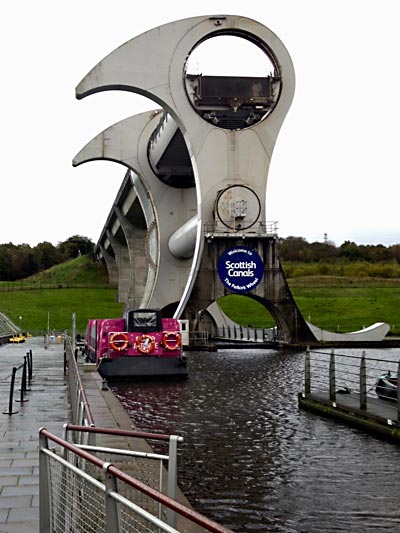 |
|
|
|
| |
This marvel of modern mechanism lifts or lowers a boat in about five minutes. |
|
One of two horse heads in the tribute to the role of horsepower in the Scottish industrial revolution. |
|
Two very good reasons to venture south are Stirling Castle and the William Wallace Monument. Each seen from the other gives something of a feel for the openness of even the Scottish Lowlands. Seen down the barrel of one of the castle's huge cannons, the tall sandstone tower looks miniscule. It is, however, over 200 feet high. It has 246 steps visitors can climb up its inside stairways. Seen from the monument, Stirling Castle stands out from the drab background because its Great Hall was painted yellow - just as it was during the reign of its builder, King James IV of Scotland. That would have been around 1500, when the King wanted the great hall to be visible from great distances to impress both his subjects and any army foolish enough to march across the fields toward him.
| |
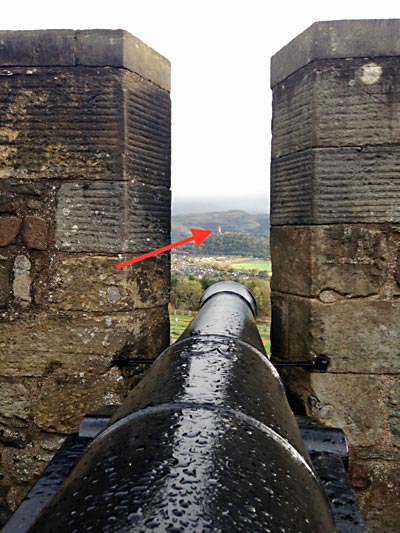 |
|
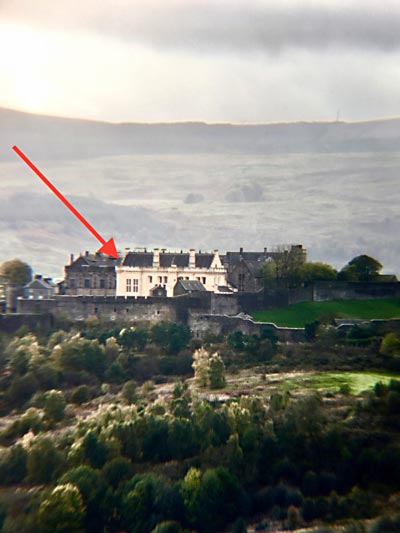 |
|
| |
The arrow points to the William Wallace Monument over the sights of a cannon in the
Stirling Castle bastion. |
|
Looking the other way from the William Wallace Monument, the yellow paint on
James IV's Great Hall stands out. |
|
While James IV's yellow Great Hall stood out from afar, within the castle complex the Palace built for his son James V and the Chapel Royal that features in the story of his great grandson James VI, command the most interest.
| |
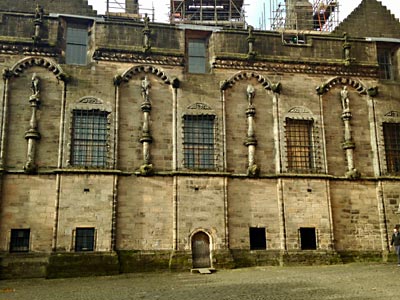 |
|
James V of Scotland offered statuary instead of bright paint for his palace within Stirling Castle. James V adorned his palace with hundreds of statues and busts of gods and goddesses of antiquity and even adorned the ceiling of his audience chamber with wooden carvings of the faces of royalty from Scotland and all of Europe. These are the "Stirling Heads" and you can see them up close in a gallery in the castle. |
|
| |
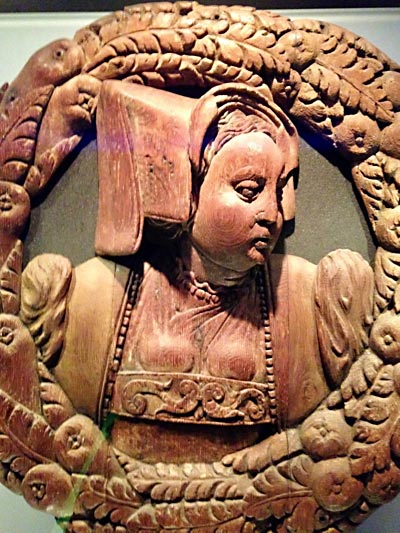 |
|
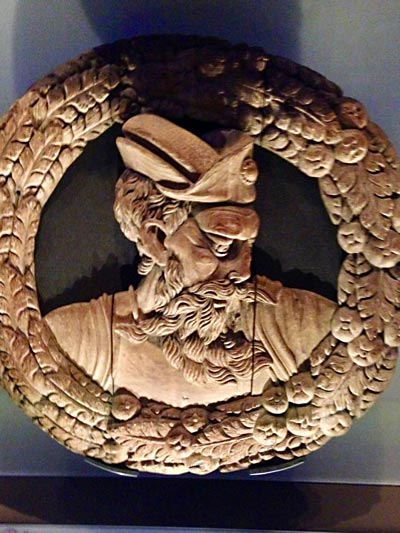 |
|
| |
Stirling Castle female head |
|
The royal heads of Europe were immortalized in the Stirling Heads. |
|
As empty as it is today, the Chapel Royal feels fairly blah. But its history is enough to fascinate and its blahness is part of that story. It was here in 1566 that Mary Queen of Scots' son, James VI, was baptized in what turned out to be the last great public Catholic mass in Scotland. Mary was forced off the throne and James VI crowned in her stead. He was one year old.
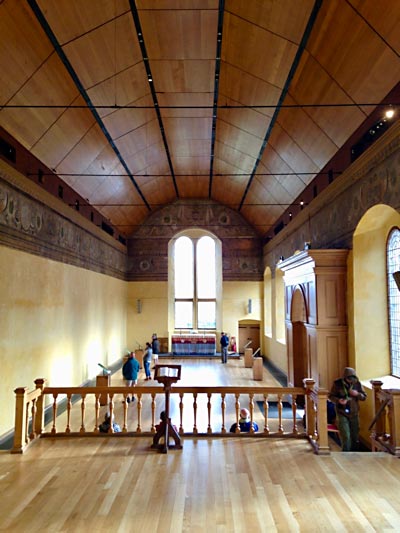
As empty as the Chapel Royal seems,
it is filled
with the memories of events
that happened here,
including the baptism of James VI of Scotland.
Across the River Forth from the castle is the William Wallace Monument standing on the peak of the Abbey Craig (a craig is the rock face of an exposed hill). The monument is Scotland's way of celebrating the national hero whose story was so poorly told in the Mel Gibson movie named for him, Braveheart. Never mind the liberties taken with history in the movie, there are plenty of opportunities to get the Scottish side of the story here in this vertical classroom. Each level houses an exhibit hall but the structure itself is a wonder, or simply an amusement, depending on your point of view.
| |
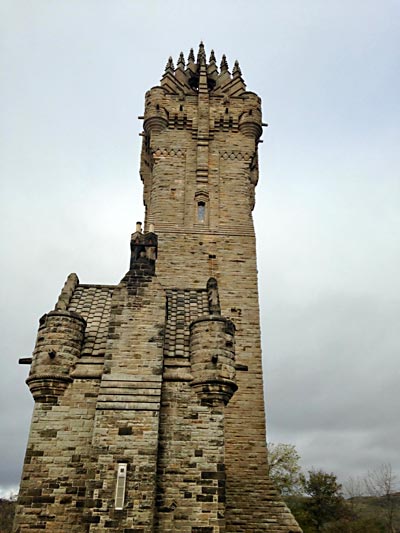 |
|
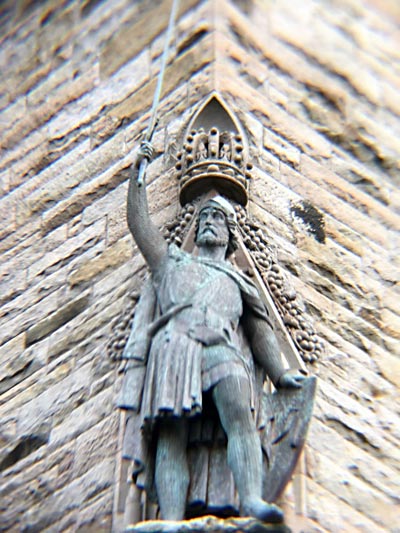 |
|
| |
The towering William Wallace Monument impresses with its size and structure.
|
|
The William Wallace Monument also impresses with details such as this statue of Wallace built into the corner of the tower |
|
|